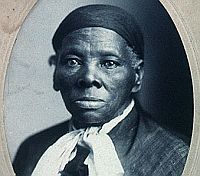 In honor of Black History Month, here is a throwback Thursday repost of a story I think is well worth telling and retelling.
In honor of Black History Month, here is a throwback Thursday repost of a story I think is well worth telling and retelling.
Born a slave, Harriet Tubman escaped and would become a leading “conductor” on the “Underground Railroad” which helped slaves escape from bondage in the South to freedom in the North and in Canada, prior to the Civil War. Nicknamed “Moses,” she is said to have made more than nineteen trips back into the slave-holding South to rescue more than 300 slaves. Her greatest rescue mission, however, came when she planned and help lead a Union riverboat raid at Combahee Ferry in South Carolina on the second of June, 1863, freeing over 720 slaves.
Tubman and black Union soldiers under the command of Union Colonel James Montgomery set off on three small Federal gunboats; the Sentinel, Harriet A. Weed, and John Adams; from Beaufort, South Carolina up the Combahee River. Tubman had scouted the route previously to identify the location of Confederate mines and troops and to determine where best to land to free the plantation slaves. One of the gunboats, the Sentinel, ran aground shortly after leaving Beaufort while the other two continued upriver.
Paul Donnelly of the New York Times described the scene on the 150th anniversary of the raid:
It is arguably the most beautiful scene ever recorded in war. Two Union gunboats, the Harriet A. Weed, and the John Adams, converted ferryboats, churning up the Combahee River with their big side paddlewheels. Steam whistles signal, while in the bow of the Adams, a small, powerful woman is… singing. From all around, hundreds hear Harriett Tubman’s call and run for the boats, for freedom. At least 727 men, women, and children escape, mothers carrying babies, including one pair of twins: the largest liberation of slaves in American history.
Perhaps half a million slaves escaped to the Union Army during the war, and in the end, the war itself liberated nearly four million. But Harriet Tubman’s achievement on the Combahee River 150 years ago was unique. And it wasn’t just her singing.
Read the rest of Donnelly’s account: Harriet Tubman’s Great Raid
The Commonwealth, a Boston newspaper, reported:
Colonel Montgomery and his gallant bank of 300 black soldiers under the guidance of a black woman, dashed into the enemy’s country, struck a bold and effective blow, destroying millions of dollars worth of commissary stores, cotton and lordly dwellings, and striking terror into the heart of rebeldom, brought off nearly 800 slaves and thousands of dollars worth of property, without losing a man or receiving a scratch. It was a glorious consummation…. The colonel was followed by a speech from the black woman who led the raid and under whose inspiration it was originated and conducted. For sound sense and real native eloquence, her address would do honor to any man, and it created a great sensation.
The unnamed black woman was, of course, Harriet Tubman.

It’s good to remember this.
Unfortunately, it’s not true.
Tubman was quite the gal, but her story has become a fairy tale. Her ‘rescues’ total about 70 people; and her part in the Combahee raid is
fictional. Her ‘afterlife’ is remarkable and worthy of all praise, but falsifying
her story belittles the true greatness of the woman.
She was heroine enough without all the frippery.
One can quibble over the number of rescues, but the events of the Great Combahee Ferry Raid are well documented. No fairy tale.
You’re right, I should clarify my comment. The raid absolutely happened.
Tubman’s participation is overblown. She provided useful Intelligence that
enabled the gunboats to bypass Confedrate mines in the river.
As to standing in the bows, singing songs of freedom and glory, well, no.
Participants in the raid failed to note Tubman’s presence among them.
There’s no doubt she made at least eleven trips to lead her people North,
and it’s known that most of them were family or kin folk. Altogether they
number about 70 people. She did work among the negro refugees and
soldiers, did organize a Home for Elderly black folks, and generally was
a thoroughly worthy individual.
Her doings were worthy enough. It’s not necessary to make stuff up to enhance her memory. She did enough in her own time to earn her place.
We can agree that the number of rescues was closer to 70 than 300. In the original post, I wrote that “she is said to have” made the rescues, which is accurate. No doubt the number has grown in the telling.
We may disagree on her role in the raid. Contemporary documents describe Tubman as the “black woman who led the raid and under whose inspiration it was originated and conducted.” See the Commonwealth, Vol 1, No. 45, (Boston, Massachusetts), July 10, 1863.